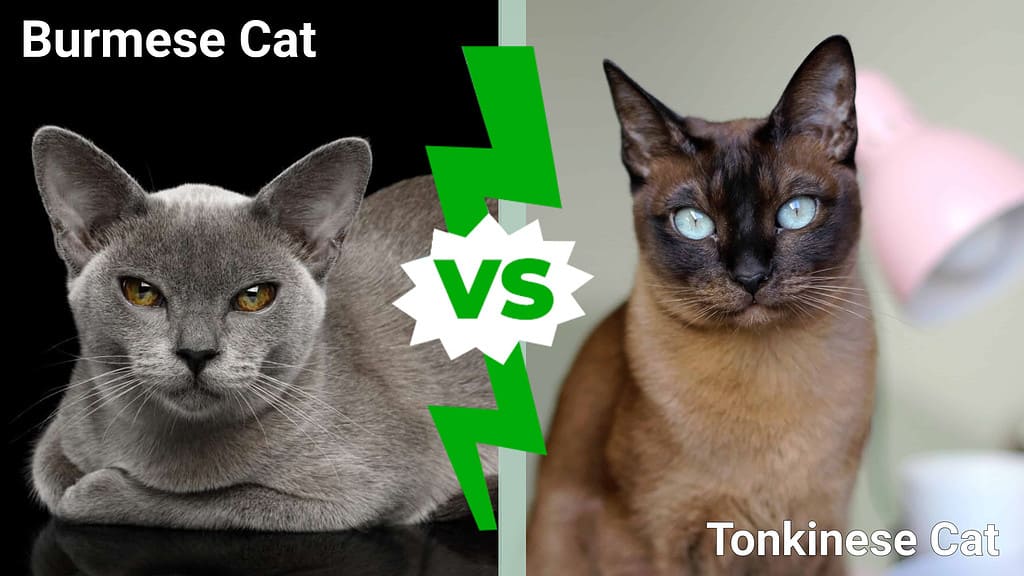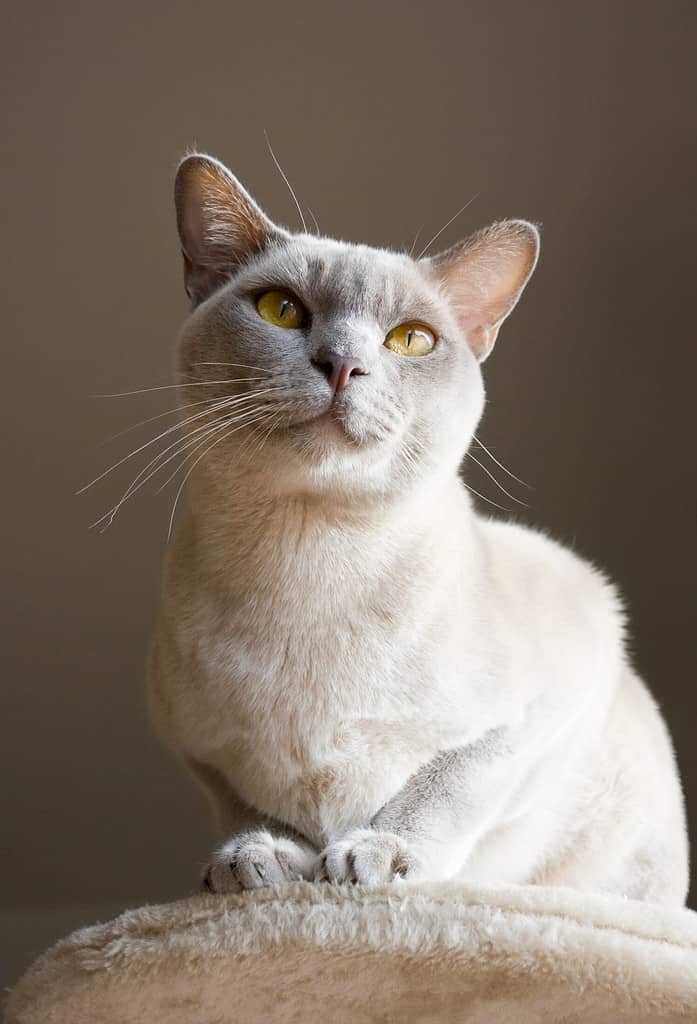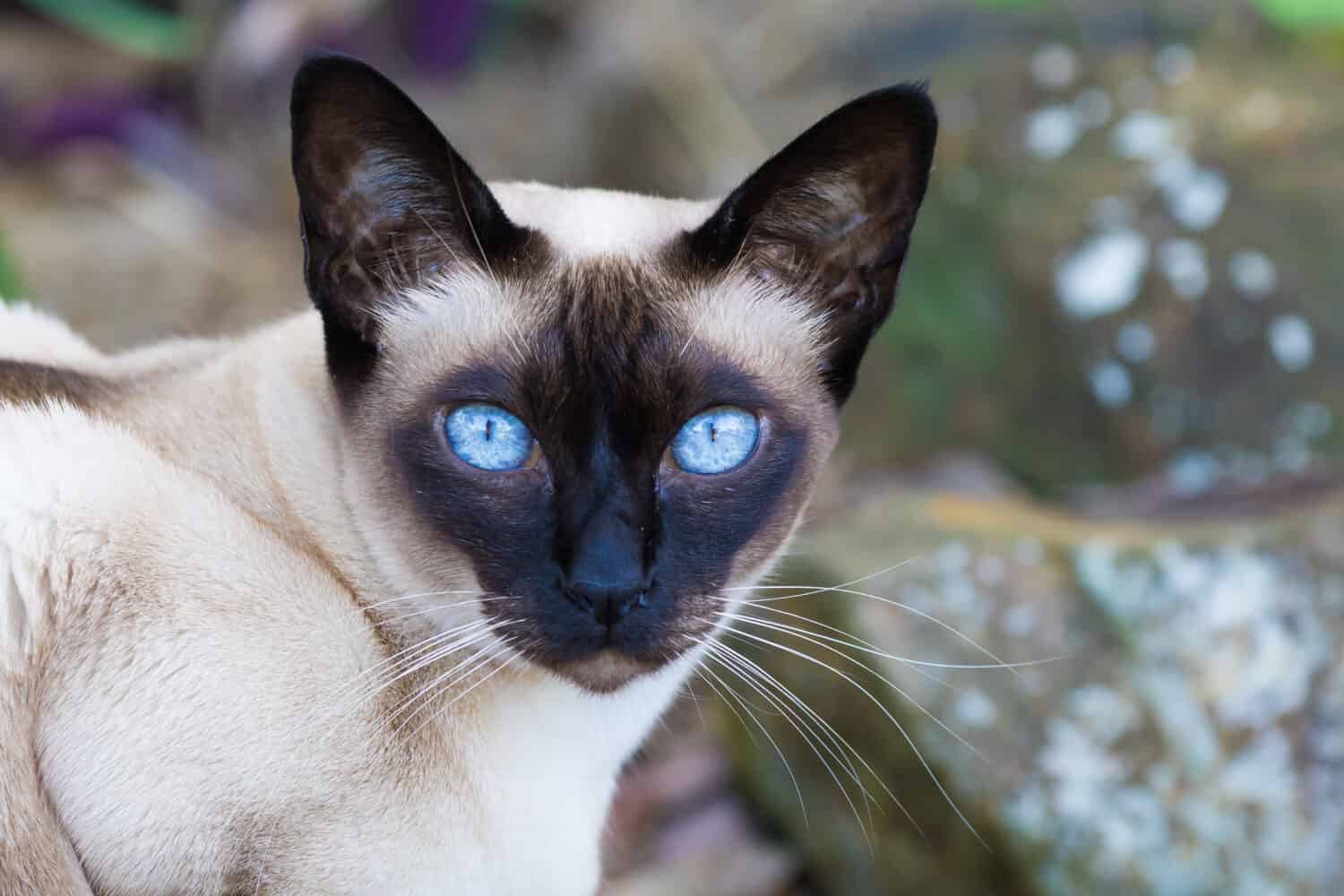
Unlike dogs, cat breeds don’t come in multiple sizes and shapes. It’s as if the cat refused to give up its basic body type for the amusement of mere humans. The cats depicted in ancient Egyptian sculptures are indistinguishable from most contemporary cat breeds, including the Burmese and the Tonkinese. But these two sleek and beautiful beasts do have some key differences.
The Burmese Cat

Burmese
cats love to play!
©snowturtle/Shutterstock.com
Most Burmese cats are descendants of a brown cat called Wong Mau. She was born in Burma, now Myanmar, and brought to the United States in 1930. There, she was bred to a Siamese cat called Tai Mau, then bred again to one of her own sons. This was the beginning of the Burmese breed.
Characteristics
There are actually two versions of the Burmese: The British, which is the traditional standard, and the American, which is the contemporary version. The British Burmese has a body that’s thinner and longer than the American version. Its legs are long for the body, and the paws are tidy and oval. The tail is medium long and tapers. The Burmese’s head is wedge-shaped, its muzzle tapers, its ears are large and triangular, and it has almond-shaped eyes.
The American Burmese is a more robust-looking cat with a broad head, round eyes, a short muzzle and ears that are wider at the bottom than the ears of the British Burmese. It has medium-length legs and round paws. The eyes, whether round or almond-shaped, are golden or green. Both Burmese cats are 8 to 10 inches tall, about 18 inches long, and weigh between nine and 13 pounds. To pick one up may be a surprise, as they are heavier than they look.
The coat of a Burmese cat is short, glossy and satiny. The original color was a dark brown, though now blue, chocolate, lilac, cream, red, and even tortoiseshell coats are allowed. Cats also have champagne, platinum, fawn, apricot, cinnamon, and sable coats. Though you can find Burmese cats with Siamese type “points,” the color of the coat should be the same all over its body. The belly and other underparts can be a shade or two lighter. Spots, stripes and bars are considered flaws. Brush your Burmese cat at least once a week, check for lesions and parasites, and check the cat’s teeth and ears.
Personality
Burmese cats are adorable, playful, curious cats. They love to be around and play with their humans and are vocal in a way that reminds people of Siamese cats. However, the voice of the Burmese is said to be more melodic. They are just the pet for families and first-time cat owners and don’t like to be left alone for too long. They are even friendly toward strangers.
Because the cat is so active and playful it needs some outdoor space to run around in. It’s important to secure the space so this inquisitive and intelligent cat doesn’t get out and get into trouble. At the same time, the Burmese needs the environment around it to be peaceable.
Health Issues
Burmese cats seem to have a low level of genetic diversity, not surprising in a breed brought into existence through mother/son incest. The Cat Fanciers’ Association notices that Burmese litters are smaller and less healthy than the litters of other cats. The adults are also smaller, and the breed seems to have more problems with the immune system. Traditional Burmese cats from Australia and Europe are more susceptible to diabetes than other cats, though this isn’t true for American Burmese, a key difference between the two cats. There’s just enough genetic difference to spare American cats from a heightened risk. Some British Burmese cats also have dangerously low potassium levels. Genetic tests are available to find out if your Burmese cat is susceptible to these or other disorders. Despite all of this, the Burmese is considered an overall healthy cat and should live between 10 and 16 years.
The Tonkinese Cat

A key difference between Tonkinese and Burmese cats is that “official” Tonkinese cats are allowed to have blue eyes.
©Sallye/Shutterstock.com
One key difference that separates the breeds is that the Tonkinese cat is allowed beautiful, jewel-blue eyes. Tonkinese eyes can be gold or green like that of the Burmese, but aquamarine eyes are preferred. Alternatively, blue eyes disqualify a Burmese from the show ring.
Some contemporary Tonkinese cats look very much like old-fashioned Siamese cats. Some people may not be able to tell them apart. Indeed, a Tonkinese is the result of breeding a Siamese and a Burmese cat. People now understand that Wong Mau was a Tonkinese, though there was no word for what she was back then.
Another key difference between Tonkinese and Burmese cats is that the Tonkinese breed arose twice. One breeder crossed a Siamese with a Burmese in the United States, and another crossed a Siamese with a Burmese in Canada. Cat fanciers considered the Tonkinese a crossbreed until 2001, when it became a breed of its own. Even though the cat was “created” in North America, its name comes from a region of Indochina, possibly as a nod to the Southeast Asian origins of its parents.
Conformation
The Tonkinese is about the same size as the Burmese, though it’s not as long and slender as the Siamese nor as robust as the Burmese. It’s about 7 to 10 inches tall, 28 inches long and weighs up to 12 pounds. Like the Burmese, it is heavier than it looks when you pick it up. The coat is short but not as short and satiny-sleek as the Burmese’s. There’s also a partially long-haired version of the Tonkinese called the Tibetan cat.
The legs and tail of the Tonkinese cat are slender, and its paws are oval. The head is a rounded wedge, and the muzzle is blunt, and it has the somewhat almond-shaped eyes of the British Burmese. You’ll notice its ears are closer to the outside of the head.
Traditionally, the Tonkinese’s coat has a mink pattern, which means that the body is a lighter shade of the color of the face, tail, ears, legs, or points. However, the Tonkinese can have a point pattern like its Siamese ancestors, which means its points can be much darker than the rest of the body. The coat color can also be solid. Colors include platinum, cinnamon, red, cream, black, blue, and chocolate. The coat can also have tabby or tortoiseshell patterns. However, the only colors the Cat Fancier’s Association and the World Cat Federation allow to be shown are black, brown, blue, chocolate, lilac, or platinum. Like the Burmese, you’ll need to groom your Tonkinese’s coat at least once a week. One key difference from the Burmese is that the Tonkinese is a heavier shedder.
Personality
The Tonkinese has the playful, kittenish, people-oriented personalities of both of its parents. They are fairly talkative cats, and their voices resemble the sweet tones of their Burmese ancestors as opposed to the yowl of the Siamese. The Tonkinese loves to be cuddled and is a wonderful cat for a family with young children. The cat’s instinct is to get along well with other pets in the house, though you’ll need to make sure that other pets can get along with the cat. It doesn’t like to be left alone for long periods, and an animal playmate is just the thing when everyone’s at work or school. The Tonkinese is also welcoming of houseguests.
Health Issues
The Tonkinese is also considered a healthy cat, but it doesn’t have the traditional Burmese’s susceptibility to diabetes. It is susceptible to problems such as gingivitis, which is an inflammation of its gums. Because of this, you should learn to know how to brush your cat’s teeth — it can be done! — and keep up its dental hygiene with the help of the vet.
Tonkinese cats are also more subject to feline lower urinary tract disease, which is not only painful but dangerous to the cat. Other diseases you may look out for when it comes to your Tonkinese are amyloidosis and inflammatory bowel disease. Amyloidosis happens when protein accumulates in the cat’s internal organs, including its liver or kidneys. If your cat has renal amyloidosis, you’ll see it needing to drink all the time, needing to urinate frequently, and vomiting. This disease can be life-threatening. Inflammatory bowel disease presents in the cat much like it presents in humans. Symptoms are gastrointestinal pain, diarrhea, nausea, and vomiting.
Because of the Tonkinese cats’ susceptibility to these problems, you should feed them a diet that supports the health of its teeth and urinary tract.
Another Key Difference: Tonkinese Might Not Breed True
Another key difference between the cats can be seen in their litters. Tonkinese cats are basically crossbreeds, and mating two of them won’t necessarily result in all of the kittens having the traditional mink pattern. Some will have a point pattern like a Siamese ancestor and others may have a solid coat.
The queens of both cats are pregnant for around 65 days and give birth to an average of five kittens, though the largest litter ever recorded was from a Tonkinese. She had 19 kittens at a time! Like the Burmese, the Tonkinese cat lives between 10 and 16 years, though some have lived as long as 20 years.
Thank you for reading! Have some feedback for us? Contact the AZ Animals editorial team.








